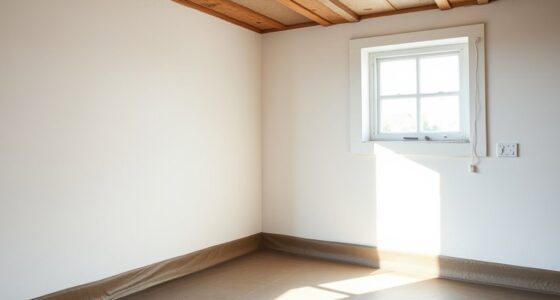Regrouting your bathroom tiles is a simple, cost-effective way to refresh your shower and floors while preventing water damage. Start by carefully removing the old grout with tools, then thoroughly clean and dry the joints. Choose a grout color that matches or contrasts with your tiles, mix it smoothly, and apply evenly using a float. Finish by cleaning excess and curing the grout properly. Keep going to discover expert tips for a flawless finish and long-lasting results.
Key Takeaways
- Carefully remove old grout with a grout removal tool to prevent tile damage.
- Clean and dry the joints thoroughly before applying new grout for optimal adhesion.
- Choose grout colors that match or contrast with your tiles to enhance your bathroom’s aesthetic.
- Apply grout evenly with a float, pressing firmly into the joints, then wipe excess with a damp sponge.
- Allow the grout to cure fully before cleaning to ensure a long-lasting, refreshed look.

Over time, bathroom tiles can develop cracks and stains in the grout that not only look unsightly but also compromise the room’s hygiene. When you notice these issues, it’s tempting to consider a full tile replacement, but regrouting offers a much simpler and cost-effective solution. Regrouting involves removing the old, damaged grout and applying fresh material to revitalize the appearance of your shower or floor. If you’re comfortable with a bit of DIY work, you can tackle this project yourself using straightforward techniques that save money and give you a sense of accomplishment.
Regrouting is a simple, cost-effective way to refresh and maintain your bathroom tiles.
First, you’ll want to carefully remove the existing grout using a grout removal tool or a small utility knife. Be gentle to avoid damaging the tiles themselves. Once you clear out the old grout, clean the joints thoroughly to remove dust, debris, and any lingering mold or mildew. This step is *essential* for ensuring that the new grout adheres properly and lasts longer. After cleaning, let the area dry completely before applying the new grout.
When selecting grout, *think about* your preferred grout color options to match or contrast with your tiles. Classic white provides a clean, timeless look, but darker shades can hide stains and make cleaning easier over time. Colored grout can add a pop of personality or complement your tile design, giving your bathroom a fresh, cohesive appearance. You can even choose custom grout colors if you want something unique. Once you’ve chosen your grout, mix it according to the manufacturer’s instructions, ensuring a smooth, workable consistency.
Applying the new grout is straightforward: use a rubber float or a grout trowel to spread it evenly across the joints, pressing it in firmly. Make sure to work diagonally to avoid pulling grout out of the joints. After filling all gaps, remove excess grout from the tile surface with a damp sponge, being careful not to disturb the freshly applied grout in the joints. Let the grout cure as recommended, then gently wipe the tiles with a clean cloth to remove any residual haze. Additionally, understanding reliable whole-home backup power options can help maintain your home’s safety during unexpected outages, ensuring your improvements are protected.
Regrouting isn’t just about aesthetics; it also restores the functionality of your tiles by sealing the joints against moisture and mold. With some patience and attention to detail, you can give your bathroom a noticeable upgrade. DIY techniques make this process accessible, and with a variety of grout color options, you can customize the look to match your style. Ultimately, regrouting is a practical, satisfying way to refresh your shower and floors without the hassle of a full tile replacement.
Frequently Asked Questions
How Long Does Regrouting Typically Take?
Regrouting usually takes between 2 to 4 hours, depending on the size of your area and the extent of grout cleaning needed. You’ll want to remove old grout, prepare the surface, and apply new grout carefully. If your tiles require tile repair or extensive cleaning, it might take a bit longer. Planning ahead and working steadily guarantees a smooth process, leaving your shower and floors looking fresh and well-maintained.
Can Regrouting Fix Mold and Mildew Issues?
In the days of knights and dragons, mold and mildew were fierce enemies, and today, regrouting can still help you battle them. Regrouting can fix mold and mildew issues by removing old grout where mold hides and replacing it with fresh material. Plus, sealing the new grout helps prevent future mold growth. Regular mold prevention and grout sealing keep your bathroom cleaner, healthier, and looking sharp.
Is Regrouting Suitable for All Tile Types?
Regrouting is suitable for most tile types, but it’s crucial to take into account your specific tiles and grout. If your tiles are delicate or porous, regrouting might require special care or professional help. Regular tile maintenance and grout cleaning help prolong the life of your grout and prevent issues, making regrouting a worthwhile option when grout becomes stained or damaged. Always assess your tile type before proceeding.
What Are the Signs Indicating Regrouting Is Needed?
Your tiles might be crying out for regrouting if the grout color has faded or darkened, like a sunset losing its glow. Cracks, chips, or mold around the grout lines are clear signs. Whether you choose a professional or DIY approach, these issues signal it’s time to refresh. Don’t wait until water seeps behind; regrouting restores both beauty and integrity, making your space look new again.
How Often Should Bathroom Regrouting Be Performed?
You should consider regrouting your bathroom every 2 to 3 years, especially if you notice grout cleaning becomes difficult or if you spot cracks and mold. Regular tile repair and grout cleaning help maintain your bathroom’s appearance and prevent water damage. Don’t wait until grout deterioration worsens—timely regrouting keeps your tiles looking fresh, prevents leaks, and extends the life of your shower and floors.
Conclusion
Regrouting your bathroom tiles is like giving your space a fresh breath of life, transforming a once dull, cracked surface into a shining heart of your home. Think of the new grout as the white picket fence around a cozy garden—protecting and beautifying what’s inside. With each stroke, you’re not just renewing tiles; you’re restoring the sanctuary where your mornings begin and evenings unwind. Embrace this small change, and watch your bathroom become a symbol of renewal and comfort.









